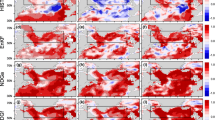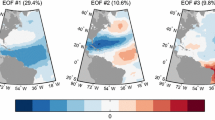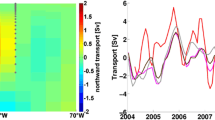Abstract
A suite of statistical atmosphere-only linear inverse models of varying complexity are used to hindcast recent MJO events from the Year of Tropical Convection and the Cooperative Indian Ocean Experiment on Intraseasonal Variability/Dynamics of the Madden–Julian Oscillation mission periods, as well as over the 2000–2009 time period. Skill exists for over two weeks, competitive with the skill of some numerical models in both bivariate correlation and root-mean-squared-error scores during both observational mission periods. Skill is higher during mature Madden–Julian Oscillation conditions, as opposed to during growth phases, suggesting that growth dynamics may be more complex or non-linear since they are not as well captured by a linear model. There is little prediction skill gained by including non-leading modes of variability.






Similar content being viewed by others
References
Cassou C (2008) Intraseasonal interaction between the Madden–Julian Oscillation and the North Atlantic Oscillation. Nature 455:523–527. doi:10.1038/nature07286
Cavanaugh N, Shen SSP (2014) Northern hemisphere climatology and trends of statistical moments documented from GHCN-daily surface air temperature station data from 1950–2010. J Clim. doi:10.1175/JCLI-D-13-00470.1
Ferranti L, Palmer T, Molteni F, Klinker E (1990) Tropical-extratropical interaction associated with the 30–60 Day oscillation and its impact on medium and extended range prediction. J Atmos Sci 47:2177–2199
Gottschalck J, Wheeler M, Weickmann K et al (2010) A framework for assessing operational Madden–Julian oscillation forecasts: a CLIVAR MJO working group project. Bull Am Meteorol Soc 91:1247–1258. doi:10.1175/2010BAMS2816.1
Jiang X, Waliser DE, Wheeler MC et al (2008) Assessing the skill of an all-season statistical forecast model for the Madden–Julian Oscillation. Mon Weather Rev 136:1940–1956. doi:10.1175/2007MWR2305.1
Jones C, Carvalho L, Higgins RW et al (2004) A statistical forecast model of tropical intraseasonal convective anomalies. J Clim 17:2078–2095
Kanamitsu M, Ebisuzaki W, Woollen J et al (2002) NCEP–DOE AMIP-II Reanalysis (R-2). Bull Am Meteorol Soc 83:1631–1643. doi:10.1175/BAMS-83-11-1631
Kang I-S, Kim H-M (2010) Assessment of MJO Predictability for boreal winter with various statistical and dynamical models. J Clim 23:2368–2378. doi:10.1175/2010JCLI3288.1
Kemball-Cook S, Weare B (2001) The onset of convection in the Madden–Julian Oscillation. J Clim 14:780–793
Kessler W, Kleeman R (2000) Rectification of the Madden–Julian Oscillation into the ENSO cycle. J Clim 13:3560–3575
Klingaman NP, Woolnough SJ, Jiang X et al (2014) Vertical structure and diabatic processes of the Madden-Julian oscillation: linking hindcast fidelity to simulated diabatic heating and moistening. J Geophys Res (to be submitted)
Kondrashov D, Chekroun MD, Robertsona W, Ghil M (2013) Low-order stochastic model and “past-noise forecasting” of the Madden–Julian Oscillation. Geophys Res Lett 40:5305–5310. doi:10.1002/grl.50991
Lau K, Chan P (1985) Aspects of the 40–50 Day oscillation during the northern winter as inferred from outgoing longwave radiation. Mon Weather Rev 113:1889–1909
Lau K, Chan P (1988) Intraseasonal and interannual variation of the tropical convection: a possible link between the 40–50 day oscillation and ENSO? J Atmos Sci 45:506–521
Liebmann B, Smith C (1996) Description of a complete (interpolated) outgoing longwave radiation dataset. Bull Am Meteorol Soc 77:1275–1277
Lin H, Brunet G, Derome J (2008) Forecast skill of the Madden–Julian Oscillation in two Canadian atmospheric models. Mon Weather Rev 136:4130–4149. doi:10.1175/2008MWR2459.1
Lo F, Hendon H (2000) Empirical extended-range prediction of the Madden–Julian Oscillation. Mon Weather Rev 128:2528–2543
Madden R, Julian P (1971) Detection of a 40–50 day oscillation int he zonal wind in the tropical Pacific. J Atmos Sci 28:702–708
Maharaj EA, Wheeler MC (2005) Forecasting an index of the Madden-oscillation. Int J Climatol 25:1611–1618. doi:10.1002/joc.1206
Majda AJ, Franzke C, Crommelin D (2009) Normal forms for reduced stochastic climate models. Proc Natl Acad Sci USA 106:3649–3653. doi:10.1073/pnas.0900173106
Maloney ED (2000) Modulation of hurricane activity in the Gulf of Mexico by the Madden–Julian Oscillation. Science 287:2002–2004. doi:10.1126/science.287.5460.2002
Martin ER, Schumacher C (2011) Modulation of Caribbean precipitation by the Madden–Julian Oscillation. J Clim 24:813–824. doi:10.1175/2010JCLI3773.1
Matthews AJ, Meredith MP (2004) Variability of Antarctic circumpolar transport and the Southern Annular Mode associated with the Madden–Julian Oscillation. Geophys Res Lett. doi:10.1029/2004GL021666
Newman M, Sardeshmukh P, Winkler C, Whitaker JS (2003) A study of subseasonal predictability. Mon Weather Rev 131:1715–1732
Newman M, Sardeshmukh PD, Penland C (2009) How important is air–sea coupling in ENSO and MJO evolution? J Clim 22:2958–2977. doi:10.1175/2008JCLI2659.1
OrtizBevia M (1997) Estimation of the cyclostationary dependence in geophysical data fields. J Geophys Res 102:13473–13486
Pegion K, Sardeshmukh PD (2011) Prospects for improving subseasonal predictions. Mon Weather Rev 139:3648–3666. doi:10.1175/MWR-D-11-00004.1
Penland C (1989) Random forcing and forecasting using principal oscillation pattern analysis. Mon Weather Rev 117:2165–2185
Penland C, Magorian T (1993) Prediction of Nino 3 sea surface temperatures using linear inverse modeling. J Clim 6:1067–1076
Penland C, Matrosova L (1994) A balance condition for stochastic numerical models with application to the El Nino-southern oscillation. J Clim 7:1352–1372
Penland C, Sardeshmukh P (1995) The optimal growth of tropical sea surface temperature anomalies. J Clim 8:1999–2024
Perron M, Sura P (2013) Climatology of non-gaussian atmospheric statistics. J Clim 26:1063–1083. doi:10.1175/JCLI-D-11-00504.1
Reichler T, Roads J (2005) Long-range predictability in the tropics. Part II: 30–60-day variability. J Clim 18:634–650
Roundy PE, Gribble-Verhagen LM (2010) Variations in the flow of the global atmosphere associated with a composite convectively coupled oceanic kelvin wave. J Clim 23:4192–4201. doi:10.1175/2010JCLI3630.1
Straub KH (2013) MJO initiation in the real-time multivariate MJO index. J Clim 26:1130–1151. doi:10.1175/JCLI-D-12-00074.1
Subramanian AC, Jochum M, Miller AJ et al (2011) The Madden–Julian Oscillation in CCSM4. J Clim 24:6261–6282. doi:10.1175/JCLI-D-11-00031.1
Sura P, Newman M, Penland C, Sardeshmukh P (2005) multiplicative noise and non-gaussianity: a paradigm for atmospheric regimes? J Atmos Sci 62:1391–1409. doi:10.1175/JAS3408.1
Vitart F, Leroy A, Wheeler MC (2010) A comparison of dynamical and statistical predictions of weekly tropical cyclone activity in the southern hemisphere. Mon Weather Rev 138:3671–3682. doi:10.1175/2010MWR3343.1
Von Storch H, Xu J (1990) Principal oscillation pattern analysis of the 30- to 60-day oscillation in the tropical troposphere. Clim Dyn 4:175–190
Waliser D, Jones C (1999) A statistical extended-range tropical forecast model based on the slow evolution of the Madden–Julian Oscillation. J Clim 12:1918–1939
Waliser D, Moncrief M (2007) The Year of Tropical Convection (YOTC) Science plan: a joint WCRP-W WRP/THORPEX International Initiative. WMO/TD No. 1452, WCRP-130, WWRP/THORPEX-No 9. WMO, Geneva, Switzerland, pp 1–24
Waliser DE, Stern W, Schubert S, Lau KM (2003) Dynamic predictability of intraseasonal variability associated with the Asian summer monsoon. Q J R Meteorol Soc 129:2897–2925. doi:10.1256/qj.02.51
Wallace J, Gutzler D (1981) Teleconnections in the geopotential height field during the northern hemisphere winter. Mon Weather Rev 109:784–812
Wheeler MC, Hendon HH (2004) An all-season real-time multivariate MJO index: development of an index for monitoring and prediction. Mon Weather Rev 132:1917–1932. doi:10.1175/1520-0493(2004)132<1917:AARMMI>2.0.CO;2
Wheeler M, Weickmann K (2001) Real-time monitoring and prediction of modes of coherent synoptic to intraseasonal tropical variability. Mon Weather Rev 129:2677–2694
Winkler C (2001) A linear model of wintertime low-frequency variability. Part I: formulation and forecast skill. J Clim 14:4474–4494. doi:10.1175/1520-0442(2001)014<4474:ALMOWL>2.0.CO;2
Yoneyama K, Zhang C, Long C (2013) Tracking pulses of the Madden–Julian Oscillation. Bull Am Meteorol Soc. doi:10.1175/BAMS-D-12-00157.1
Zhang C (2001) Intraseasonal perturbations in sea surface temperatures of the equatorial eastern pacific and their association with the Madden–Julian Oscillation. J Clim 14:1309–1322
Zhang C, Gottschalck J, Maloney ED et al (2013) Cracking the MJO nut. Geophys Res Lett 40:1223–1230. doi:10.1002/grl.50244
Acknowledgments
This material is based partly upon work supported by the National Science Foundation under Grant No. 0731520. We also gratefully acknowledge funding from ONR (Grants N00014-10-1-0541, N00014-13-1-0139, and N00014-13-1-0704) and NSF (OCE-0960770). We would like to thank Prashant Sardeshmukh, Cecile Penland, and Mathew Newman for conversations regarding LIM. Allen would like to thank Kathy Pegion of NOAA for her time and discussions towards understanding the LIM framework and its applications. We greatly appreciate the insightful comments of the four reviewers, whose input greatly enhanced the quality of this manuscript. In addition, Allen is grateful for the Wallace Fellowship administered by The University of Miami that helped to foster collaborative efforts among the authors.
Author information
Authors and Affiliations
Corresponding author
Rights and permissions
About this article
Cite this article
Cavanaugh, N.R., Allen, T., Subramanian, A. et al. The skill of atmospheric linear inverse models in hindcasting the Madden–Julian Oscillation. Clim Dyn 44, 897–906 (2015). https://doi.org/10.1007/s00382-014-2181-x
Received:
Accepted:
Published:
Issue Date:
DOI: https://doi.org/10.1007/s00382-014-2181-x




